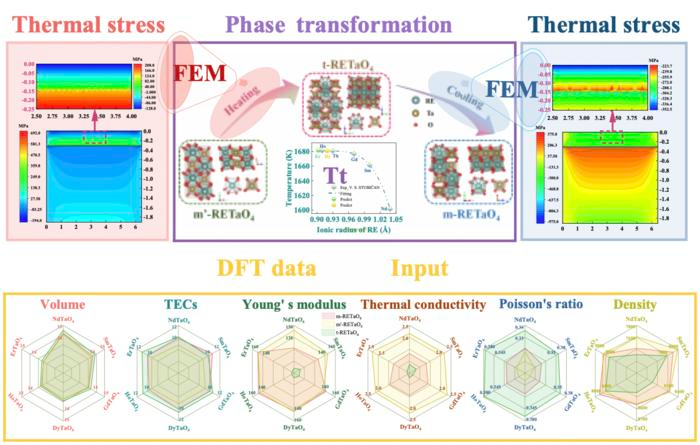In a recent paper published in the Journal of Advanced Ceramics, a group of material scientists from Kunming University of Science and Technology have developed a high-throughput multiscale evaluation method for thermal stress in thermo-bromic ceramics, which can serve as a valuable theoretical foundation and guide for life prediction and reverse design of coating materials.

A high-throughput multiscale evaluation method for thermal stress considering the phase transition of multilayer structured systems. The thermophysical properties calculated by first-principles calculations are used as the input of finite element simulations. Image Credit: Journal of Advanced Ceramics, Tsinghua University Press
Thermal barrier coatings (TBCs) are commonly used in gas turbine engines to increase operating temperatures and enhance engine efficiency. During operation, the ceramic layer in TBCs undergoes a phase transition, which involves a significant change in volume. This change increases the concentration of thermal stress, ultimately leading to the failure of the TBC. Therefore, it is crucial to quantitatively assess the level and distribution of thermal stress caused by the phase transition in the ceramic layer.
Recently, a team of material scientists, spearheaded by Prof. Xiaoyu Chong, developed a high-throughput multiscale assessment approach for thermal stress in TBCs.
This method integrates first-principles calculations with finite element simulations, accounting for the phase transition of the top ceramic materials. It enables a quantitative evaluation and visualization of thermal stress in real TBC structures during thermal cycling through multifield coupling. This advancement offers a crucial theoretical foundation and guidance for predicting the lifespan and reverse engineering of coating materials.
In this report, we develop a high-throughput multiscale evaluation method for thermal stress in multilayered systems, which considers the phase transition of the top ceramic materials by coupling first-principles calculations with finite element simulations. This approach can quantitatively evaluate and visualize the thermal stress in TBCs based on real structures, considering the actual service environment subjected to thermal cycling.
Xiaoyu Chong, Professor and Faculty, Department of Materials Science and Engineering, Kunming University of Science and Technology
“The thermophysical properties input in finite element simulations are calculated by first-principles calculations, in which the multiscale method can consider the influence of phase transition and temperature and simultaneously reduce the cost and time of obtaining thermophysical properties by experiments,” said Chong and one young expert whose research interests focuses on the field of high-throughput multiscale computing and machine learning.
Direct observation of the phase transformation process in ceramic coatings is challenging. This process, which occurs in the high-temperature service environment of the coatings, significantly complicates thermal stress testing and is a primary cause of coating failure. Furthermore, there is a lack of quantitative testing and characterization methods to adequately assess these transformations.
The finite element simulations coupled with multiple physical fields can visualize and quantitatively evaluate thermal stress of TBCs. However, the thermophysical properties required for finite element simulations are derived from experimental measurements, which ignores the effects of phase transition and temperature.
Mengdi Gan, Study First Author and Ph.D. Student, Kunming University of Science and Technology
Gan was supervised by Prof. Xiaoyu Chong.
Researchers have developed an innovative high-throughput multiscale evaluation method that combines finite element simulations with first-principles calculations. This method is specifically designed for assessing thermal stress in multilayered systems, incorporating the phase transition dynamics of the top ceramic materials. By simulating real service conditions, including heat cycling, this approach can quantitatively evaluate and visually represent the thermal stress in TBCs based on their actual structures.
First-principles calculations provide the necessary thermophysical properties for the finite element simulations. This multiscale method not only accounts for temperature variations and phase transitions but also significantly reduces the time and cost associated with the experimental determination of thermophysical properties.
The research introduces rare earth tantalites (RETaO4) as ceramic layers in thermal barrier coatings. The findings indicate that thermal stress escalates rapidly near the phase transition temperature, particularly evident in the TBCs_GdTaO4 system. The substantial shifts in Young's modulus and thermal conductivity around the phase transition temperature are likely responsible for this sharp increase in thermal stress.
Notable temperature drop gradients and low thermal stress fluctuations are features of the TBCs_NdTaO4 and TBCs_SmTaO4 systems that help to prolong the TBCs' service life. This method makes it easier to predict the mechanisms of failure and offers theoretical direction for the reverse design of TBC materials to produce systems with low thermal stress.
Mengdi Gan, Tianlong Lu, Wei Yu, and Jing Feng from Kunming University of Science and Technology in Kunming, China’s Faculty of Materials Science and Engineering, are among the other contributors.
The Yunnan Fundamental Research Projects, the Yunnan Major Scientific and Technological Projects, the National Natural Science Foundation of China, and the Project Funds of the “Xingdian Talent Support Program” provided funding for this work.
Journal Reference:
Gan, M., et al. (2024) Capturing and visualizing the phase transition mediated thermal stress of thermal barrier coating materials via a cross-scale integrated computational approach. Journal of Advanced Ceramics. doi.org/10.26599/JAC.2024.9220864.
Source: https://www.tup.tsinghua.edu.cn/en/index.html